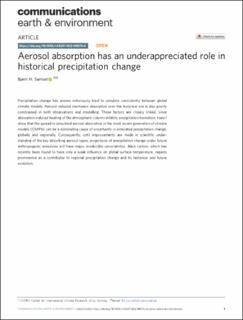| dc.contributor.author | Samset, Bjørn Hallvard | |
| dc.date.accessioned | 2024-02-20T14:03:00Z | |
| dc.date.available | 2024-02-20T14:03:00Z | |
| dc.date.created | 2022-11-17T10:31:29Z | |
| dc.date.issued | 2022 | |
| dc.identifier.citation | Communications Earth & Environment. 2022, 3 (1), . | en_US |
| dc.identifier.issn | 2662-4435 | |
| dc.identifier.uri | https://hdl.handle.net/11250/3118724 | |
| dc.description.abstract | Precipitation change has proven notoriously hard to simulate consistently between global climate models. Aerosol induced shortwave absorption over the historical era is also poorly constrained in both observations and modelling. These factors are closely linked, since absorption induced heating of the atmospheric column inhibits precipitation formation. Here I show that the spread in simulated aerosol absorption in the most recent generation of climate models (CMIP6) can be a dominating cause of uncertainty in simulated precipitation change, globally and regionally. Consequently, until improvements are made in scientific understanding of the key absorbing aerosol types, projections of precipitation change under future anthropogenic emissions will have major, irreducible uncertainties. Black carbon, which has recently been found to have only a weak influence on global surface temperature, regains prominence as a contributor to regional precipitation change and its historical and future evolution. | en_US |
| dc.language.iso | eng | en_US |
| dc.publisher | Springer Nature ltd | en_US |
| dc.rights | Navngivelse 4.0 Internasjonal | * |
| dc.rights.uri | http://creativecommons.org/licenses/by/4.0/deed.no | * |
| dc.title | Aerosol absorption has an underappreciated role in historical precipitation change | en_US |
| dc.title.alternative | Aerosol absorption has an underappreciated role in historical precipitation change | en_US |
| dc.type | Peer reviewed | en_US |
| dc.type | Journal article | en_US |
| dc.description.version | publishedVersion | en_US |
| dc.source.pagenumber | 0 | en_US |
| dc.source.volume | 3 | en_US |
| dc.source.journal | Communications Earth & Environment | en_US |
| dc.source.issue | 1 | en_US |
| dc.identifier.doi | 10.1038/s43247-022-00576-6 | |
| dc.identifier.cristin | 2075375 | |
| dc.relation.project | Norges forskningsråd: 248834 | en_US |
| dc.relation.project | Norges forskningsråd: 324182 | en_US |
| dc.relation.project | Norges forskningsråd: 324556 | en_US |
| cristin.ispublished | true | |
| cristin.fulltext | original | |
| cristin.qualitycode | 1 | |

